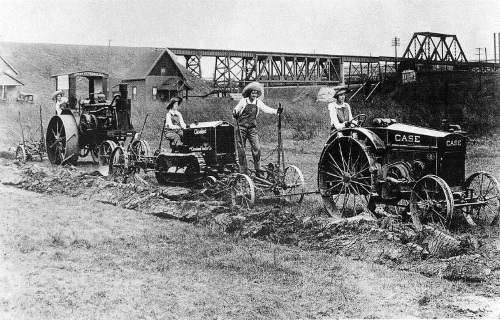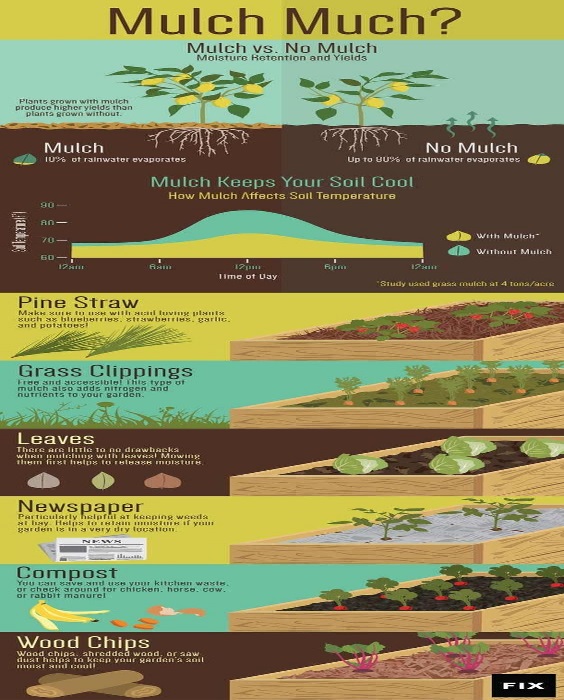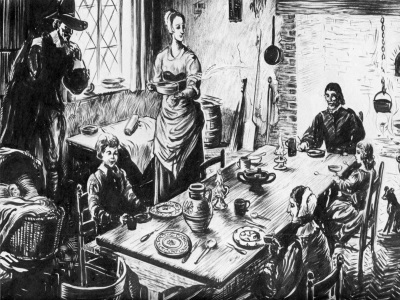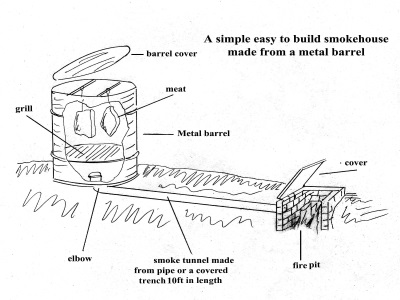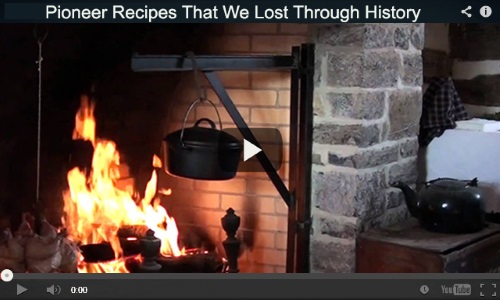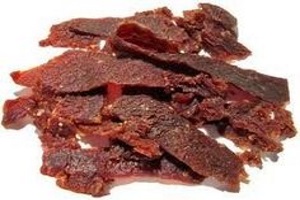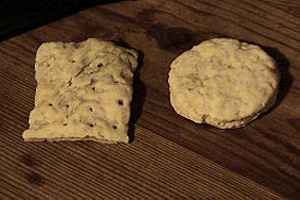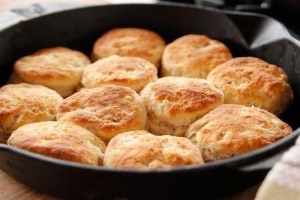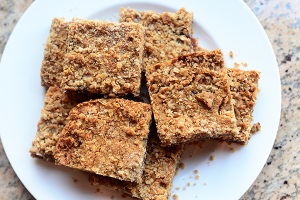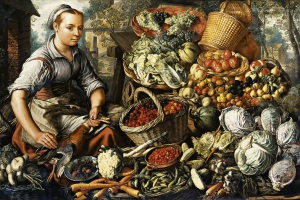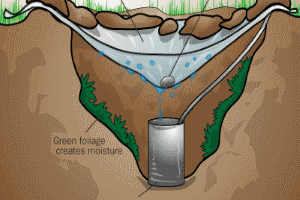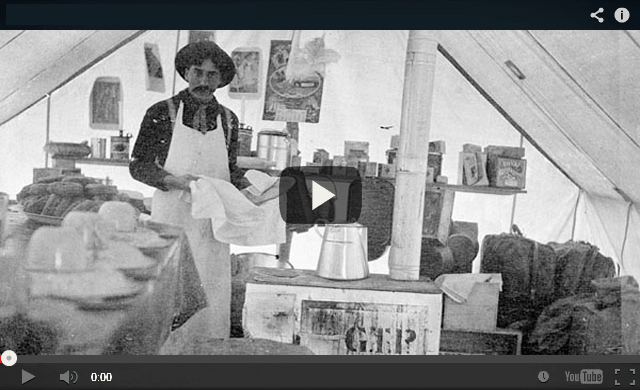Pioneer Lessons Gardening & Cooking Tips (Forgotten Lessons of Self-Sufficiency from the pioneers)
We can learn much from the American pioneers. From the pioneer provision list, to seed saving and their cooking equipment and recipes, take note of techniques and tools used by the pioneers who “bugged out” West from 1840- 1890 along the Oregon Trail.
A pioneer family faced many challenges in staying healthy and finding enough food for the entire family. A well-grown garden could produce a great deal of food for the family to eat. Do you have any gardening tips that have been passed down in your family?
The garden was where you found eighty percent of your food, of course, but it also provided medicine, fragrances, dyes, and aromatic herbs for the home, laundry – even laying out the dead.
The plant placement approach of the pioneers was informed by two very different sources – 17th century European garden writers and Native American practices. In the European tradition, placement of plants within the garden could be dictated by fragrance. Sweet smelling herbs and flowers were likely planted just under the kitchen windows. Strong smelling plants, such as cabbages, onions, and chives were as far from the windows as possible.
Perennials that didn’t need to be completely pulled each year were planted together so that their roots would not be disturbed by the harvesting of annual crops. Parsnips and carrots grew together. Radishes, lettuces, and onions were constantly in a state of being pulled – and so were grown together. Melons, cucumbers, squashes and pumpkins were planted alone, yet edged by cabbages to make the best use of the space – considering their growth habit.
Hedges inside and outside the perimeter fencing included thrift, hyssop, germander, lavender, cotton, marjoram, savory, thyme, juniper, yew and even roses. Sheets could be stretched and dried across the fragrant hedges.
Today, when we think of garden fences, we think of pickets. These are the evenly spaced, vertical boards on display outside all of the big box stores. And it is true that by the late 1800s, people could order mass produced picket fences from catalogs from anywhere in the country. But people in simpler, rural areas were building versions of the medieval paling fences well into the late 19th century. For these fences, split logs or even sturdy branches could be tied to horizontal split logs, or even planted vertically into the ground. Logs would be placed tightly together, unlike how they are today, to keep out even very small animals.

The women were advised to create raised beds based on geometric patterns, the most basic of which would have been a four square garden. A path around the entire perimeter of the beds, just inside the fencing made harvesting and amending the beds easier. The beds were first made of raised, well-draining soil. Unlike so many European farmers, the pioneers didn’t enjoy the benefit of quantities of well-rotted manure from large herds of pastured animals. They likely learned from Native Americans to amend the soil with dead fish and eels. After raising the amended soil, timber could be split and staked at the corners so the beds remained upright and the soil contained.
General garden tips
Egg-box seed trays – use cardboard egg boxes as seed trays. Not only do they provide the perfect home for a seedling to grow, but when ready to be planted out, each cup can be individually cut out and planted straight into the ground where the cardboard will disintegrate and the plant roots can grow undisturbed.
Newspaper also makes great pots for seedlings. Invest in a paper pot maker and save on plastic pots! Just like the egg boxes, seedlings can be planted straight into the ground where the newspaper will provide protection for the seedling until it eventually rots.
Save all those lolly pop sticks in summer – they make excellent plant labels. You can also use plastic yoghurt pots – cut the sides into strips and write on them with a permanent marker pen.
Old tights and stockings make very good plant ties. They are strong but soft, so won’t harm the plant stems.
To help germinate peas, beans and sweet pea seeds soak them in cold water for a day. This helps the tough outer shell of the seed to break open which then helps to speed up germination. This process is called ‘chitting’.
Use a wire brush to remove rust from garden tools and then rub in some linseed oil to help protect.
Use a weak solution of water and washing up liquid to control green fly on roses and other plants. Planting garlic cloves around your rose bush also helps!
Natural fertilizers
If you like a boiled egg for breakfast, save the shells as well as the boxes. Crushed egg shells make excellent fertilizer when worked into the soil. There is also evidence that the sharp edges of crushed egg shell can help keep slugs and snails away from precious young plants.
Used coffee granules can help provide acid in alkaline soil. They too have some success against slugs and snails when sprinkled around the base of plants.
Use the nutrients from the water of a fish tank to feed plants in outdoor planters.
Ash from wood fires, or wood burning stoves, makes a useful additive to the compost heap. It can be also be applied directly to the ground and dug in as a natural source of potassium and trace elements. It also has a liming effect, so wood ash can remedy excessively acidic soils.
Many of us are trying to be environmentally conscious these days and water conservation is part of that. If you are like me and have a number of plants to water, there are several ways you can accomplish that task while saving water at the same time.
One of the most obvious ways to conserve is to collect rainwater. This can be done using rain barrels or any container large enough to hold a significant amount of water. The setup can be elaborate or as simple as large trash cans. Large plastic drums are sometimes available for free from fast food restaurants, janitorial supply companies, schools, or other sources. Make sure they are cleaned well before using them for storing water.
A rain garden is a planted area that allows water from roof runoff to be absorbed into the ground to water surrounding plants. Gravel drain fields can be utilized at the base of downspouts to spread and direct the runoff from a roof to nearby rain gardens.
Using a moisture meter can help determine when your houseplants or potted plants really need more moisture and thus help avoid excessive watering and plant loss.
Use mulch or top-dress your potted plants. Potted succulents often benefit by being top-dressed with pea gravel or crushed rock, and if you use are using a moisture meter you can be certain when it’s time to water them. A few of the numerous potted plants that can benefit from being top-dressed with mulch or compost include: amaryllis, podocarpus, gardenia, clivia, spider lily, lantana, sansevieria, oleander, hoya and brunfelsia.
Make a reservoir for your plants and let them absorb water as needed. Fill a two-liter plastic bottle with water and place a small piece of sponge just slightly larger than the bottle opening into the neck. Bury the neck of the bottle into the soil near the plant stem. The sponge will help dispense water slowly over a period of time. You can also cut the bottom off the bottle to allow it to be refilled and left in place indefinitely.
If you’ve always wanted a pond or water garden, think smaller. They can be as small as a cup, pot, bucket or half whiskey barrel. Anything that holds water can become a water garden.
There are some less obvious ways to water plants that you may not have thought about. When you boil or steam vegetables, don’t pour the water down the drain. Save the cooled liquid and use it to water potted plants. Many plants will respond well to the added nutrients. Fruit and vegetable peels can also be put into the water and soaked for about eight hours to add additional nutrients. Strain out the peelings and toss them into the compost pile.
Cooled leftover coffee and tea can be used either diluted or undiluted to water plants. And when changing your fish tank water, use the old water on your plants. That can bean economical way to fertilize them as well.
PIONEER KITCHEN
Food back then wasn’t usually prepared to impress guests or to provide a means of entertainment. It was appreciated on a much deeper level – you might say, even a spiritual one. Food meant another day of life for early Americans and their families. Life was hard, but it was also simple and good. Simple and good recipes and various food crafting skills were not only treasured, but were crucial to know, and were passed down from one generation to the next.
Here are some old guidelines from the 1800’s on how they stored meat. Since they did not have refrigeration, they recommended these methods for use during the summer. I do not recommend you try these methods today. They are not that dependable.
RELATED : OLD FASHIONED PRESERVING-GRANDPA’S RECIPE FOR CURED SMOKED HAM
RELATED : HOW TO MAKE A DAKOTA SMOKELESS FIRE PIT
Cover the meat with sour milk or buttermilk and store in a cellar.
In areas where the nights are cool, hang the meat in the open from a tree so any breeze can pass around it. Make sure the meat is brought inside at dawn. During the day, wrap the meat in a tarp and store in a shady place. Make sure the blowflies don’t deposit eggs on the meat.
Keep the meat away from rain and damp nights. Any meat that gets wet must be cooked or jerked immediately.
Consider drying your meat and hunting. Meat spoiled quickly, so the settlers smoked, dried and salted the meat prior to leaving on their journey. Not as tasty as beef jerky, because it tasted more along the lines of shoe leather, but it was nutritious just the same.
Pioneers hunted and trapped wild game (venison) and small animals (squirrel, hare and in lean times mice) to supplement the dried meats they hauled in their covered wagons. They hunted a variety of fowl from partridge and pigeons to geese and ducks. They also caught fish as they travelled rivers and lakes. They ate a lot of sowbelly, which is what we call bacon today.
Quick bread.
The pioneers baked quick breads (flour mixed with water) over the fire by wrapping the wet dough around a stick when the day was getting short and bellies needed filling. A quick biscuit was made with a quart of sour cream and a spoonful of saleratus and just enough salt and flour to make the dough stiff.
Biscuits and bread.
If they had time, pioneers kneaded yeast biscuits and breads on the trail, by supper the bread had risen
and was ready to bake in a cast iron dutch oven over the fire. Dry yeast wasn’t available until 1870, so they made their own yeast. To make their yeast, they brought saleratus (the pioneer version of baking soda, which made the bread rise). Saleratus needed to mix with an acidic food or chemical, such as cream of tartar to activate the leavening process.
Corn bread.
Much more like pancakes made with ground corn meal, pioneers made Johhny cakes. Here’s a homestead recipe on how to make pioneer style corn bread
1 cup yellow corn meal
1/3 cup flour
2 tsp baking powder
1/2 tsp salt
2/3 cup milk (1%)
1 large egg
3 TBSP veg oil or shortening (I used jalapeno olive oil)
1-2 tsp sugar (optional-nutrition values includes 2 tsp)
Add oats to your pantry.
Third on the list of pioneer foods were oats. Pioneers ate mostly steel-cut oats (not the flat rolled stuff). The proportions were 2 tablespoons oats to 2 cups water! It was an arduous process to
cook and stir, but the result was a creamy, silky smooth porridge, and not the nutty flavor you might expect. As corn gained in popularity, porridge made from oats became less a part of the diet. Pioneers then preferred corn mush!
Rough and Ready Soup
Crack a shin-bone well, boil it in five or six quarts of water four hours.
Take half a head of white cabbage, three carrots, two turnips, and three onions; chop them up fine, and put them into the soup with pepper and salt, and boil it two hours.
Take out the bone and gristle half an hour before serving it.
If you can learn how to make a soup using whatever you happen to have on hand and then store ingredients commonly used in soups, you’ll be more than ready for TEOTWAWKI cooking. Add some simple corn pone and it’s quite a large meal.
One thing you will notice as you study pioneer cooking and their recipes is that many things like stew, soup and beans took a long time to cook. If you will learn how to use a good quality pressure cooker, you can shorten the cooking time considerably and save on fuel. Once you’re comfortable using a pressure cooker, try using it outdoors on a campfire. The only challenge to this is maintaining as even a temperature as possible, but it can be done.
Fruits and Vegetables
Vegetables and fruits were cooked fresh or preserved by drying or pickling. Jelly could be made from wild grapes and blackberries.The entire family helped with the making of apple butter. Long hours were spent cutting up the apples. Before sunup of the big day a fire was started under a large copper kettle. The apples were added and the cooking began. All day the apples cooked over a slow fire. The apples always had to be stirred, so as not to burn them. By the end of the day, the apple butter would be done and put away in jars for the winter.
RELATED : My Grandmother’s Recipe : Blackberry Honey Jam – No White Sugar
Learn how to distill and purify water.
Water is the most important lesson of any survival skill overview. Often pioneers had no choice but to drink water made by human and animal waste. Coffee made it taste better. They could either drink foul water or die of dehydration, which wasn’t much of a choice. They “cured” sickness and disease with peppermint, whisky and rum. Vinegar was also a medicinal tonic to help ease heir health woes. What a life!
One in ten travelers died the journey. Clean water was hard to find and the pioneers often died of dehydration or the perils of bitter alkaline water (too high ph), parasites in water and disease
borne mosquitoes.
The simplest levels of filtration can be achieved by running water through coffee filters, layers of paper towels, a tightly woven cloth, a bandana, or anything that will remove the big stuff you can see. You can also help filter the water by allowing it to settle for awhile to allow the heavy particles settle to the bottom, then pouring the water into another container.
Boiling
One of the most common methods for purifying water is to boil it. Everyone varies on how long to boil from 1 to 10 minutes. When water boils, any bacteria that may have been living in it will be killed, thus reducing your chance of getting sick when you drink the water. When done boiling, remove from the heat source, cool and drink. Remember, boiling will not remove contaminants such as heavy metals, salts, and chemicals.
Pack vinegar. Pioneers packed vinegar as a tonic. While it won’t cure cholera or dysentery, vinegar has medicinal qualities. Thanks to the acetic acid, vinegar has antimicrobial properties.
Our grandfathers had more knowledge than any of us today and thrived even when modern conveniences were not available. They were able to produce and store their food for long periods of time. The Lost Ways is the most comprehensive book available. All the knowledge our grandfathers had, in one place.Here’s just a glimpse of what you’ll find in the book:
Table Of Contents:
Making Your Own Beverages: Beer to Stronger Stuff
Ginger Beer: Making Soda the Old Fashioned Way
How North American Indians and Early Pioneers Made Pemmican
Wild West Guns for SHTF and a Guide to Rolling Your Own Ammo
How Our Forefathers Built Their Sawmills, Grain Mills,and Stamping Mills
How Our Ancestors Made Herbal Poultice to Heal Their Wounds
What Our Ancestors Were Foraging For? or How to Wildcraft Your Table
How North California Native Americans Built Their Semi-subterranean Roundhouses
Our Ancestors’Guide to Root Cellars
Good Old Fashioned Cooking on an Open Flame
Learning from Our Ancestors How to Preserve Water
Learning from Our Ancestors How to Take Care of Our Hygiene When There Isn’t Anything to Buy
How and Why I Prefer to Make Soap with Modern Ingredients
Temporarily Installing a Wood-Burning Stove during Emergencies
Making Traditional and Survival Bark Bread…….
Trapping in Winter for Beaver and Muskrat Just like Our Forefathers Did
How to Make a Smokehouse and Smoke Fish
Survival Lessons From The Donner Party
Get your paperback copy HERE
Here’s just a glimpse of what you’ll find in The Lost Ways:
From Ruff Simons, an old west history expert and former deputy, you’ll learn the techniques and methods used by the wise sheriffs from the frontiers to defend an entire village despite being outnumbered and outgunned by gangs of robbers and bandits, and how you can use their wisdom to defend your home against looters when you’ll be surrounded.
Native American ERIK BAINBRIDGE – who took part in the reconstruction of the native village of Kule Loklo in California, will show you how Native Americans build the subterranean roundhouse, an underground house that today will serve you as a storm shelter, a perfectly camouflaged hideout, or a bunker. It can easily shelter three to four families, so how will you feel if, when all hell breaks loose, you’ll be able to call all your loved ones and offer them guidance and shelter? Besides that, the subterranean roundhouse makes an awesome root cellar where you can keep all your food and water reserves year-round.
From Shannon Azares you’ll learn how sailors from the XVII century preserved water in their ships for months on end, even years and how you can use this method to preserve clean water for your family cost-free.
Mike Searson – who is a Firearm and Old West history expert – will show you what to do when there is no more ammo to be had, how people who wandered the West managed to hunt eight deer with six bullets, and why their supply of ammo never ran out. Remember the panic buying in the first half of 2013? That was nothing compared to what’s going to precede the collapse.
From Susan Morrow, an ex-science teacher and chemist, you’ll master “The Art of Poultice.” She says, “If you really explore the ingredients from which our forefathers made poultices, you’ll be totally surprised by the similarities with modern medicines.” Well…how would you feel in a crisis to be the only one from the group knowledgeable about this lost skill? When there are no more antibiotics, people will turn to you to save their ill children’s lives.
If you liked our video tutorial on how to make Pemmican, then you’ll love this: I will show you how to make another superfood that our troops were using in the Independence war, and even George Washington ate on several occasions. This food never goes bad. And I’m not talking about honey or vinegar. I’m talking about real food! The awesome part is that you can make this food in just 10 minutes and I’m pretty sure that you already have the ingredients in your house right now.
Really, this is all just a peek.
The Lost Ways is a far–reaching book with chapters ranging from simple things like making tasty bark-bread-like people did when there was no food-to building a traditional backyard smokehouse… and many, many, many more!
Books can be your best pre-collapse investment.
The Lost Ways (Learn the long forgotten secrets that helped our forefathers survive famines,wars,economic crisis and anything else life threw at them)
Survival MD (Best Post Collapse First Aid Survival Guide Ever)
Conquering the coming collapse (Financial advice and preparedness )
Liberty Generator (Build and make your own energy source)
Backyard Liberty (Easy and cheap DIY Aquaponic system to grow your organic and living food bank)
Bullet Proof Home (A Prepper’s Guide in Safeguarding a Home )
Family Self Defense (Best Self Defense Strategies For You And Your Family)
Survive Any Crisis (Best Items To Hoard For A Long Term Crisis)
Survive The End Days (Biggest Cover Up Of Our President)
SOURCE : happypreppers.com

